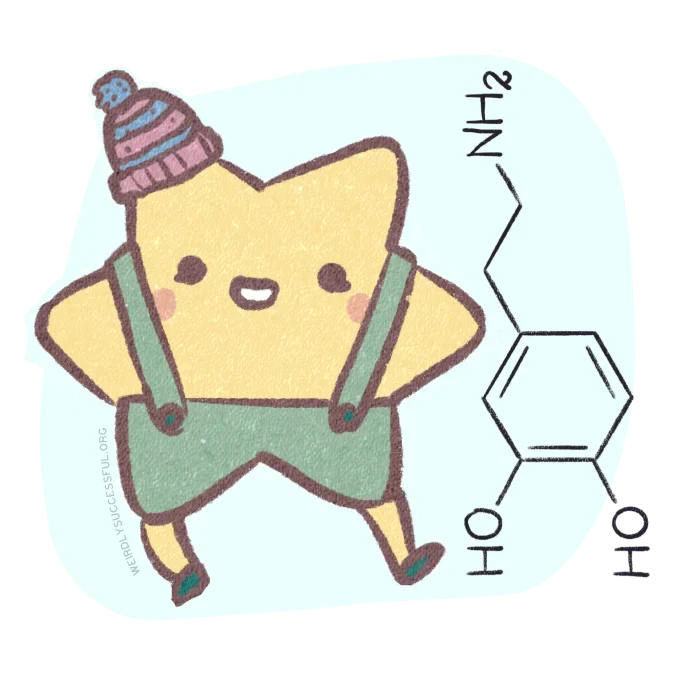What is dopamine?
Dopamine is a type of neurotransmitter. (Don’t worry, I’ll tell you in a bit what that is.) Dopamine is involved in many different functions, including movement, motivation, reward, and pleasure. It is one of the most important neurotransmitters you have to get to know if you want to understand ADHD better.
How does dopamine affect daily life?
Dopamine can influence our behaviour, our mood, and our overall sense of well-being, as well as motor control, learning, pain processing and motivation.
When we do something that feels good, like eating a delicious meal or receiving a compliment, our brain releases dopamine, which can reinforce that behaviour and make us more likely to repeat it in the future. This is a good thing; when our system does this, it is working as intended. Dopamine detoxes are unnecessary and harmful.
When dopamine is released in the brain, it can produce feelings of satisfaction. This is why it is often referred to as the “feel-good” or “pleasure” neurotransmitter. However, this is a very simplified view of the complex role dopamine has in our bodies.1
What conditions are connected to dopaminergic neurotransmission problems?
Dopamine systems have a central role in conditions like ADHD, Tourette syndrome, bipolar disorder, schizophrenia, and also Parkinson’s disease.
Dopamine plays a role in pain processing, and abnormalities with the dopamine system are present in fibromyalgia and restless leg syndrome.
Ageing brains also have changed dopamine levels which can be responsible for many neurological symptoms in old age.
How does ADHD relate to dopamine production?
ADHD is a neurodevelopmental condition that can affect the way that dopamine functions in the brain. Research has shown that individuals with ADHD may have lower levels of dopamine in certain areas of the brain, or the dopamine they have has trouble going where it needs to go, even though there is enough produced of it.2
This can lead to difficulties with motivation, reward, and attention. Some medications that are commonly used to treat ADHD, such as stimulants, work by increasing the levels of dopamine in the brain to help with symptoms, and non-stimulant medications help the already existing dopamine get where it needs to go.

What does it look like when your dopamine is not working properly?
A neurotransmitter, like dopamine, is a type of chemical messenger that helps transmit signals in the brain and other parts of the nervous system. Think of it like a little deliveryperson taking your precious cargo from one place to another.
Except when you have ADHD, dopamine acts like the courier who is a bit rubbish at their job.
You know the one.
You get the text message saying your package will be delivered today between 2 and 4, so you stay home, guarding the door, then nothing happens, then you get an e-mail that it was attempted, but you weren’t home when you clearly were.
So then you ask for a redo, and they don’t tell you when they come, until suddenly, a few days later you get an e-mail saying YOUR PACKAGE HAS BEEN DELIVERED with a picture attached with your package in YOUR BIN.
Except it’s bin day and you already hear the grinding noises of the bin truck.
So you run out in your pyjamas and slippers and chase your bin before its contents are fed to the machine.
When you finally rescue your package, you realize it has been damaged and half of the items are missing.
And just when you finally shuffle back home, tired and defeated, your phone pings with a message from the courier company asking for a five-star rating.
How does dopamine connect to the traits of ADHD?
When there is not enough dopamine running around in your brain, or there is, except they are on an 8-hour long coffee break three times a day, it will have profound effects on your life.
But having dopamine function difficulties is not as clear-cut as having an ON/OFF switch in your brain for dopamine production.
Depending on how affected dopamine production and pathways are in your brain, your ADHD traits can be very different from any other ADHDer.
Think of it like a big buffet table of traits — while you have a big stack of pancakes with some scrambled eggs on the side, someone else might have only one pancake with some blueberries, or even no pancake and just eggs.
Always be mindful when reading a list of ADHD traits that you do not have to exhibit all of them, all the time, and they don’t have to be completely debilitating to count.
Dopamine affects executive functioning
Executive function is a term used to describe a set of mental processes that are responsible for organizing, planning, initiating, and carrying out goal-directed behaviours
These processes involve the ability to regulate emotions and behaviour, switch between tasks, inhibit impulsive responses, and utilize working memory to hold and manipulate information. Executive functioning is critical for a range of everyday activities, including decision-making, problem-solving, and social interactions.
Dopamine is one of the neurotransmitters that is closely linked to executive functioning. Dopamine helps to regulate attention, motivation, and reward-based learning, which are all essential components of executive functioning. 3
When dopamine levels are balanced (meaning there are enough receptors in the brain, and dopamine production works as it should), individuals are better able to focus, plan and execute complex tasks, and regulate their emotions. However, when dopamine levels are imbalanced, executive functioning can be impaired, leading to difficulties in areas such as attention, impulsivity, and decision-making.
« Back to the index


